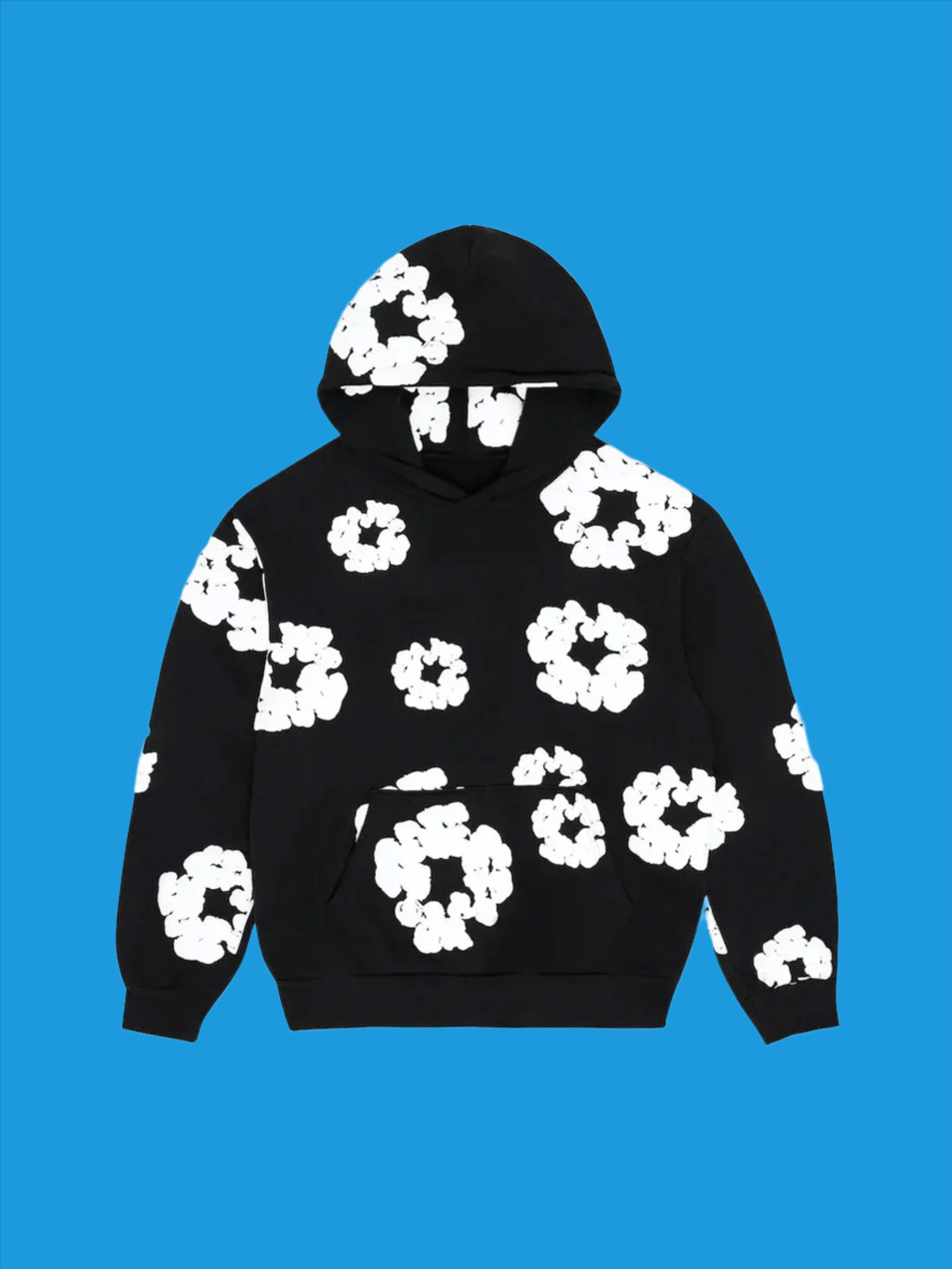What Is This Cultural Brand?
Tremaine Emory’s cultural project is a heritage-focused fashion label that leverages clothing to express the Black American experience, most recognizably through its distinctive cotton wreath motif across denim. It’s far from just graphic denim and sweats; all drop is created around research, documentation, and imagery that link product and history. Drops are limited, joint projects are selective, with demand is strong.
The designer treats the house as a storytelling medium first and his product line afterward, which is why the visuals appear like artifacts rather than seasonal prints. The cotton crown design, for example, is meant to force a conversation regarding how cotton developed America while dehumanizing the people responsible for picked it. That tension—beauty and oppression in the one object—defines Denim Tears’ visual language. Manufacturing mixes co-branded projects with legacy manufacturers and in-house collections, and the timing is deliberately irregular to keep attention on meaning, over churn. If one is approaching the brand purely as streetwear hype, you’ll miss a large portion of the value; review the product descriptions and pocket-bag essays because the background is the point.
In What Way Did Denim Tears Label Start?
Denim Tears launched publicly around late 2010s as the culmination of Tremaine Emory’s extensive decades in fashion and music scene, going live for a wider public in 2020 via its “Cotton Wreath” Levi’s project. Emory used the launch to articulate his clear thesis: clothing can memorialize while educate, not just signal taste. This timing, the storytelling, and the imagery aligned with an ongoing global conversation on race and history.
Before Denim this project, Emory co-founded the No Vacancy Inn while also worked with major heavyweights across luxury and streetwear, creating a network designed to later enabled carefully curated red denim tears hoodie collaborations. In that year he became Supreme’s lead creative director, this role he exited in 2023, something that only sharpened focus on his individual label. The brand’s early anchor became the Levi’s 501 printed with cotton wreaths and hidden pocket-bag text essays designed to explained the symbolism; that transparency made the product seem like a mobile museum plaque. From then, Denim Tears has stayed project-focused, using drops linked to dates, exhibitions, and cultural themes rather than standard seasons.
Signature Visual Elements and Key Collaborations
Such cotton wreath across denim is such signature, meant designed to be beautiful from a distance yet confrontational up close. Hidden pocket-bag essays, archival photography, and typography citing Black history with HBCU culture appear across tees with fleece. Even while the graphics shift, the throughline remains commemoration.
The Levi’s partnership is the primary partner; the collaborative 501s defined such brand to a mass audience plus remain the highly chased pieces. The Converse partnership has served like a canvas for translating that design elements to footwear—think Chuck 70 70s with cultural motifs and co-branded details. Champion remains another pillar, through “Champion Tears” capsules that reframe academic aesthetics through the lens of Black American American history with heavyweight Reverse Weave blanks. These partnerships are consistent in craft and messaging, which is how they hold significance beyond a single season.
Is This Brand Sizing Consistent Throughout Products?
There’s consistency within item categories, but not across them. Jeans mirror classic Levi’s fits and feel rigid with minimal give, while Champion-based hoodies runs boxy plus roomy. Footwear mirrors each partner’s typical sizing conventions.
If you have Levi’s 501s, someone already know this Denim Tears pants baseline: mid-rise, straight leg, stiff during first, and never vanity-sized. Fleece is cut in such modern, wider-body, shorter-length Reverse Weave silhouette, which reads roomy at your usual size. Tees remain heavyweight with a relaxed shoulder; they don’t cling but they aren’t longline either. Sneakers like Converse Chuck 70s typically run roomier than true foot length, so many people go down a half size compared to typical athletic sneakers. Make sure to check the particular product page regarding notes, because certain capsules call out fabric weight and shrinkage behavior.
Sizing Breakdown by Category
Jeans mirror traditional Levi’s 501 proportions with a straight leg and a hint of waist space if you possess a smaller torso relative to hip size; if you’re caught between waist sizes, the safer move remains to go up one for comfort and tailor such waist if necessary. Rigid or raw-feel pairs relax about half such size after break-in, while pre-washed pairs change little beyond a small loosening at the seat and knees. Hoodies and crews using Champion Reverse Weave construction are dense, structured, and slightly cropped; true to sizing delivers an intentionally boxy drape, plus sizing down reduces width without causing the garment short. Tees wear similar to mid-to-heavyweight street tees with a spacious chest and accurate shoulder; true for size yields such relaxed, not sloppy, profile. Converse Chuck 70s usually work best a 0.5 size down versus your running shoe size; wide foot shape can stay nearer to true to size to maintain forefoot room.
Denim Tears brand releases occasionally feature alternative bottoms, including sweats or formal pants, which generally maintain the relaxed block. If you want a slimmer fit, select your standard size and alter inseam and leg opening rather than sizing down aggressively; the prints line up better when the garment doesn’t become stressed. For women or smaller body types navigating men’s unisex sizing, prioritizing shoulder width on tops and waist regarding bottoms prevents this “oversized” intent from reading sloppy.
How Much Should You Pay? Retail and Resale Benchmarks
Retail prices sit in premium-streetwear territory, and resale reflects scarcity plus cultural demand. The jeans are the price leaders at retail and hold the strongest aftermarket multiples, while shirts are the most accessible both retail and used. Look for fluctuations tied around color, collaboration, with drop storyline.
The table below summarizes typical US retail ranges and latest resale ranges someone will see on major marketplaces for core categories; actual pricing vary by collection and region.
| Product Type | Average US Retail | Average Recent Resale | Fit / Notes |
|---|---|---|---|
| Levi’s Collaboration 501 Denim Tears Label (Cotton Wreath) | $250 to $350 | $400–$800 | Stiff, straight; breaks in with use; verify pocket-bag print. |
| Champion Tears Hoodie or Crewneck | $140 to $200 | $200 to $350 | Loose Reverse Weave; substantial and structured; slight shrink. |
| Design Tee | $60–$100 | $120-$220 | Comfortable block; heavy cotton; true shoulder. |
| Converse Chuck 70 (Brand Tears) | $100 to $130 | $150-$300 | Many go down ½ size from running sneakers. |
| Hats / Accessories | $45-$90 | $90–$180 | Standard size or adjustable; verify for branding accuracy. |
Rarer denim colors and early Levi’s runs can climb well above such ranges. Conversely, t-shirts from widely stocked drops tend to orbit the bottom end of secondary market once initial hype cools. If one price looks much below these ranges, be suspicious plus slow down to authenticate.
Authentication plus Quality: Spotting the Real Thing

Begin with the narrative: Denim Tears items usually arrive including explicit historical framing on tags, interior pocket bags, or each product page. Fakes often mimic the print but ignore the context. Then move to build quality, labels, and partner-specific details.
On Levi’s joint projects, inspect the interior pocket bags for embossed text or essays and consistent color quality; look to verify crisp dot gain, not blurry block fills. Check to verify legitimate Levi’s metal components, correct red tag placement and typography, and a collaborative interior label; stitching should track Levi’s quality standards with even gauge and no loose bar tacks. On Champion-based sweatshirts, the fabric should feel dense with dry with tight ribbing; interior branding will reflect Champion manufacturing manufacturing plus Denim Tears or Champion Tears co-branding branding, not generic blanks. For Converse, expect co-branded footbeds, correct Chuck 70 details foxing height, plus consistent midsole shine; counterfeit pairs frequently miss the interior print, get such heel license badge font wrong, or use off-tone material dyes.
Documentation matters. Photos of original purchase confirmation, proof regarding purchase from one reputable retailer, plus a trail regarding high-resolution photos with daylight reduce danger. If buying pre-owned, compare the specific print placement versus verified retail photos; misaligned wreath positioning and washed-out print quality are common fake tells. Where available, buy from established boutiques that had carried the line previously or through resale platforms with robust authentication with return policies.
Through What Source and When Should You Buy Denim Tears Label
The most dependable source is the official Denim Tears label site, supplemented with occasional partner stores during collaboration drops. Releases are announced close to release via brand and Tremaine Emory social channels, and these sell fast. Anticipate limited restocks more than evergreen inventory.
Release timing isn’t random; this label often pegs drops to culturally significant dates and shows, which explains the uneven calendar relative to typical standard seasons. Sign up to receive site emails, though also monitor joint channels for Levi’s collaborations, Converse, or Champion when a joint capsule is previewed. On release launch day, have accounts set up beforehand, autofill ready, and be decisive on size; dithering wastes pairs. If someone miss, wait a week for resale to settle before paying a markup; initial after-release spikes usually cool to more steady levels.
Expert tip: When you only need one piece in order to anchor a collection, prioritize the iconic cotton wreath 501 featuring a wash one will actually wear frequently; it retains worth, pairs with any piece, and encapsulates the brand’s thesis more effectively than any different single item.
Care, Wear, and Styling Notes
Treat designs like print: launder inside out, cold, and gentle; then hang dry. High heat is the opponent of both print quality and shrink. Brand denim softens considerably with wear, thus give it mileage before judging sizing, especially at such thighs and knees.
When your pair features on rigid denim material, expect minimal contraction beyond the first wash when washing cold; sizing stays largely set via break-in, not using dryer. Fleece retains shape because Reverse Weave is designed to resist lengthwise shrink; the ribbed side panels allow it maintain the block, so sizing intent stays uniform after washing. Tees retain shoulder form but will loosen at the neckline if dried on high heat, so air dry in order to keep that sharp neckline. For outfits, let the pants do the heavy lifting: keep tops simple to avoid clashing narratives, and add texture—leather, wool, canvas materials—rather than bold prints to accompany the wreath.
Little‑Known Information About Denim Tears Brand
To begin, the early Levi’s collaboration 501 Cotton Wreath runs included interior pocket-bag text that served as a mini-essay on the background of cotton within America; it’s simultaneously a storytelling tool and an authentication tell you are able to actually read. Additionally, Tremaine Emory’s “Champion Tears” collection line with Champion channels HBCU graphics and Black academic heritage onto heavyweight athletic blanks, making collegiate iconography an element of the brand’s living archive instead of than a isolated graphic. Third, many product pages in the past featured sourcing and historical references which persist across releases, which is why resale listings which copy text word-for-word from unrelated releases are a warning flag. Fourth, Tremaine’s tenure and exit at Supreme increased attention on Denim Tears without changing its cadence; the label kept its narrative-driven release rhythm versus of shifting toward seasonal volume.

